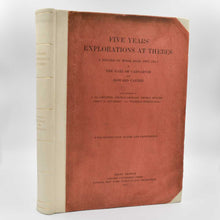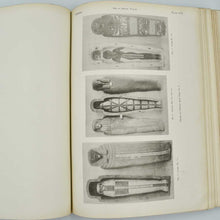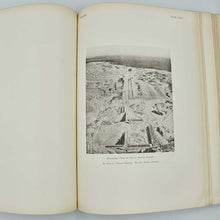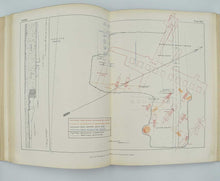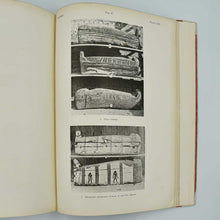
An important Step towards the Discovery of the Tomb of Tut-Ankh-Amen.
CARNARVON The Earl of, and Howard CARTER. Five Years' Explorations at Thebes. A Record of Work done 1907-1911 … With Chapters by F.Ll. Griffith, George Legrain, George Möller, Percy E. Newberry and Wilhelm Spiegelberg. Henry Frowde: Oxford University Press, London, New York, Toronto and Melbourne. 1912.
Folio. Original printed boards, sympathetically rebacked and re-cornered with pigskin in the style of the original half-vellum over boards, spine lettered and ruled in gilt; pp. xii, 100, double-page plan in four colours (counted as plate xxx), single-page plan (counted as plate lv), photogravure frontispiece with tissue guard, 77 photogravure plates, photographic illustrations to text; a little darkening to boards, very light spotting sporadically, p. 71/72 with flaw near gutter (not affecting printed surface); provenance accessioned by Manchester Public Free Library in March 1912 (stamp on blank verso of title-page), their blind-stamp to many leaves and plates.
Sole edition of one of the great and important rarities of Egyptology and archaeology in the Nile Valley. Only a very limited number of copies were printed.
It was the paucity of finds during these excavations in the Valley of Kings up until WW1 and just afterwards which led to Carnarvon reluctantly wanting to stop funding and excavations. It was Carter asking for only one more season to which Carnarvon acquiesced which led to the discovery of the tomb of Tutankhamun. Previously, Theodore Davis had emphatically stated that there were no more tombs to be found in the Valley of Kings, but Carter disagreed and wanted to make a more thorough search. It was only after dismantling the workers’ huts of the tomb of Rameses VI that the tomb was found. This book on the excavations of Thebes is a vital step in the events which led up to the discovery.
The Earl of Carnarvon "had been interested in excavation since 1889, but the opportunity did not present itself until 1906, when he began excavating at Luxor, with a permit supplied by the Egyptologist Gaston Maspero. The first six-week season yielded only an empty burial pit and a mummified cat, but Carnarvon's enthusiasm was undiminished. On the advice of Maspero he teamed up with the archaeologist and artist Howard Carter, former inspector-in-chief of antiquities in Luxor. Their partnership endured for sixteen years. Between 1907 and 1912 the two men excavated at or near Deir el Bahari on the west bank of the Nile opposite Luxor … At times they employed as many as 270 men. Their finds, which included an important tablet commemorating the expulsion of the Hyksos kings of the delta by the pharaoh Kamose in 1532 bc, were published by them in Five Years' Exploration at Thebes (1912) … Carnarvon had his eyes on the Valley of Kings, the burial place of Egypt's New Kingdom pharaohs, but the concession was held by the American Theodore Davis. Carter was convinced that the tomb of the obscure pharaoh Tutankhamun awaited discovery in the valley, and Carnarvon wanted to search for it. Davis relinquished the concession only in 1913. Carnarvon applied for it at once, but the permit was not forthcoming until 1914, just before the outbreak of the First World War" (ODNB).
WorldCat locates copies at the State Library of Victoria, Humboldt University, Berlin, in the Koninklijke Bibliotheek and at Radbout University in the Netherlands, at Leiden, and at Turin University.
#2122099





